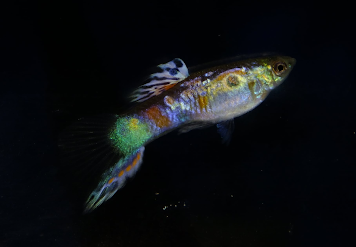Working With Vienna Emerald Swords
Do Breeders excessively concentrate their efforts on production of singular phenotypes at the expense of overall genotype?Several breeding’s made yearly and maintained in a
dozen tanks is a requiem for failure when maintaining complex phenotypes in isolation. In my
experience a minimum of 40-60 tanks are required to maintain a strain long-term. Keeping in mind, a breeding strain is not necessarily comprised
of a single phenotype. Rather many phenotypes as a collective group. At
times I run 80-100 tanks of Lowerswords, saving 50-100 drops per year. A large population allows for needed beneficial
mutations to accrue through various genetic principles and mechanisms. This same concept also allows for identification and culling of deleterious alleles, without need for drastically reducing numbers at any given point in time.
 |
| Grey Vienna Emerald Lowersword male |
Far too many breeders are focused on linear breeding’s and routinely turning a generation with each breeding result. When your fish are at a point that is satisfactory to you as a breeder it is OK to maintain a "status quo" and utilize the same generation via lateral breeding’s for 2-3 years. Backcrosses can further alleviate the perceived need to turn a generation to improve results.
In addition to multiple sex-links both X and Y, sum total genotype of "Vienna Emeralds" includes multiple autosomal genes. Both recessive and incompletely dominant. Autosomal variation, the random nature of recombination among autosomal genes, precludes production of a single "fixed phenotype" in high numbers for extended periods of time.
Mother Nature imposes this principle for a reason. That being, autosomal genes confer positive benefit only in heterozygous fashion. Attempting to maintain autosomal genes in homozygous fashion long-term confers negative benefit across multiple areas of fecundity within and beyond color-pattern, size and shape. An easy example to visualize is Sickle Cell Disease. The sickle cell anemia gene confers positive benefit to individuals and populations in heterozygous fashion, i.e., immunity from malaria. Yet, in homozygous fashion is lethal.
 |
| Grey Purple Body Lowersword male |
Another example in Guppies is autosomal incompletely dominant Purple Body (Pb). Pb mode of inheritance allows for populations to be comprised of three phenotypes: pbpb - Pbpb - PbPb in a 1:2:1 ratio. Each construes positive or negative benefit in open or closed canopy environments under a multitude of predation regimes. In breeder tanks each is used as a "tool" for propagation and maintenance of specific phenotypes. When Pb selection is narrowed wild-type, feral and domestic populations suffer in the long-term.
These same principles apply to all autosomal genes, if you know where to look. What does this mean as a breeder of autosomal genes? Rather than seeking to narrow your genotype in quest of a singular phenotype, focus your breeding program on maintenance of multiple autosomal genes, in various states of zygosity, to produce a multitude of phenotypes within your overall breeding scheme.
In turn, this will strengthen your breeding population
as a whole. Yet, allow for production of a smaller percentage of desired results across
multiple phenotypes…
 |
| Grey Vienna Emerald Lowersword male |
~~~~~~~~~~~~~~~~~~~~~~~~~~~~~~
The number of tanks you maintain as a breeder is not the point. Because it will never be enough. The point is whether you utilize your available tanks efficiently in quest of your desired result. Set your goals realistically...
~~~~~~~~~~~~~~~~~~~~


No comments:
Post a Comment